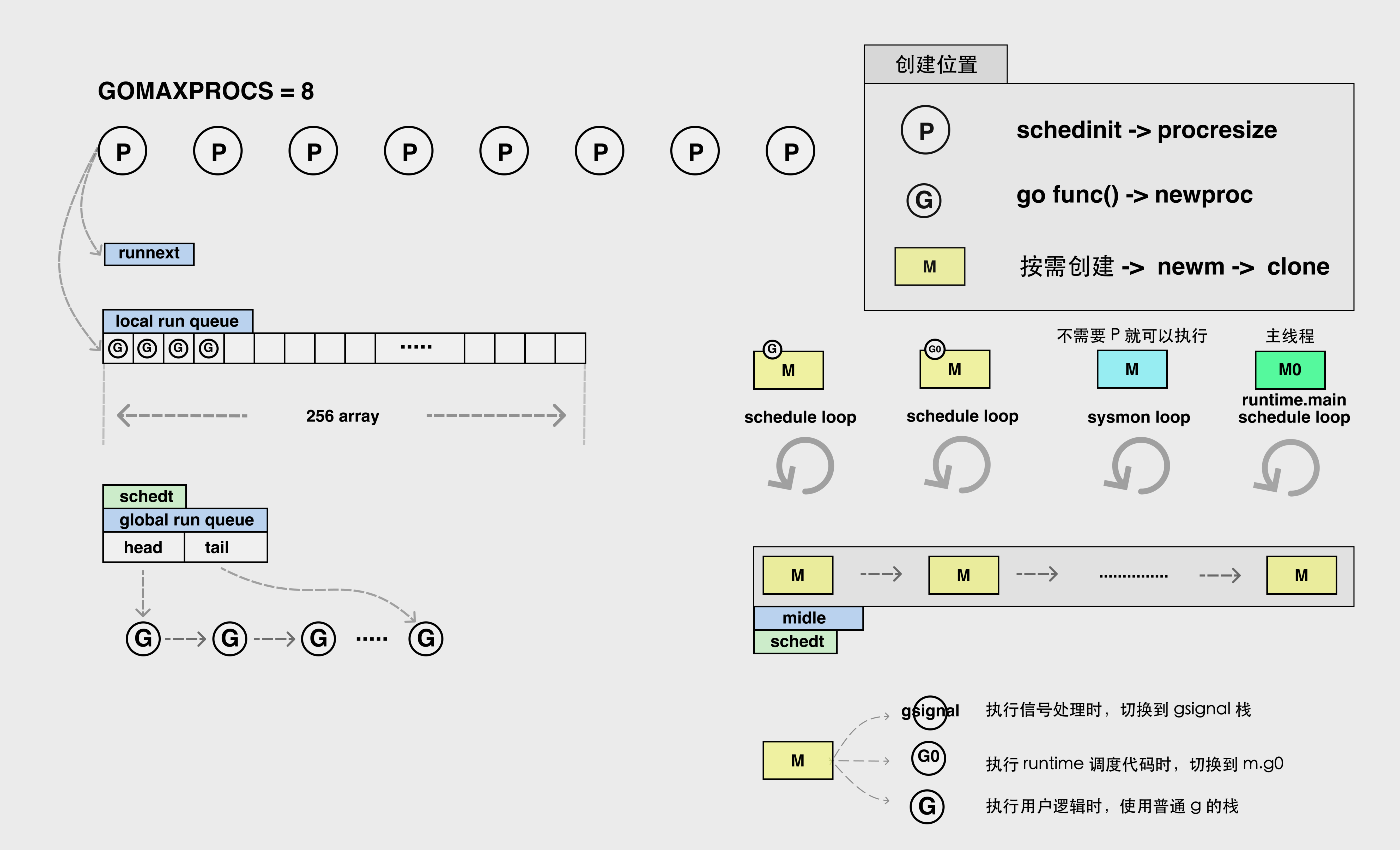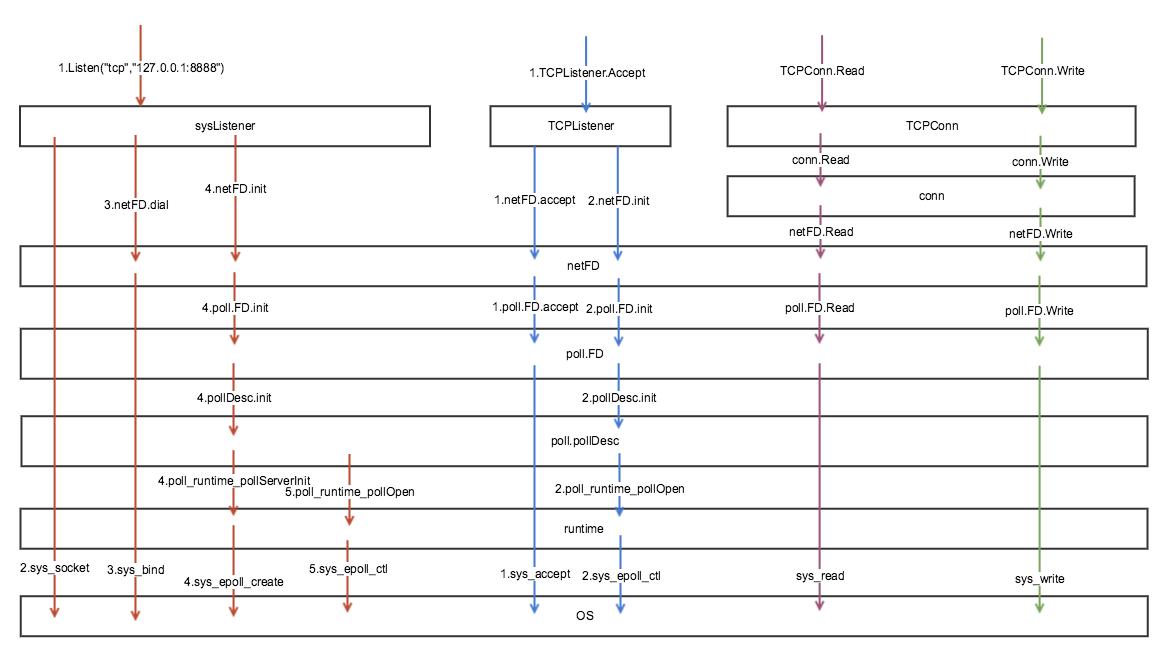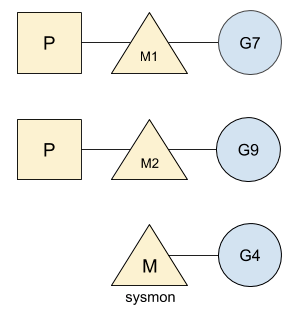1:io模型
计算机的io模型区分为多种,目前用的最多的也就是nio、epoll、select。
结合不同场景使用不同的io模型才是正解。
具体可以查看我之前写的io模型演进。io模型演进
2:golang中网络io
golang天然适合并发,为什么?一个是轻量级的协程,二个是将复杂的io进行了抽象化,简化了流程。
比如我们简单的访问一个http服务,几行简单的代码就能实现
tr := &recordingTransport{}
client := &Client{Transport: tr}
url := "http://dummy.faketld/"
client.Get(url) // Note: doesn't hit network那么golang对Io做了哪些优化呢?能实现如此简单的切换呢?
3:groutinue 针对io事件的调度
我们这里假设你对groutinue调度已经有一定的了解了。
我们知道,在go中,每个process绑定一个虚拟的machine,而在machine中,是具有一个g0的,g0在本地遍历自己的队列获取g或者从全局队列获取g。
我们也知道了,在g运行的时候,g会把执行权交给g0进行重新调度,那么在io事件中,g是怎么把事件交还给g0的呢?这时候就牵扯到我们今天的主角—-netpoll。
4:netpoll
o语言在网络轮询器中使用 I/O 多路复用模型处理 I/O 操作,但是他没有选择最常见的系统调用 select。 select 也可以提供 I/O 多路复用的能力,但是使用它有比较多的限制:
- 监听能力有限 — 最多只能监听 1024 个文件描述符,可以通过手动修改limit来改变,但是各方面成本比较大;
- 内存拷贝开销大 — 需要维护一个较大的数据结构存储文件描述符,该结构需要拷贝到内核中;
- 时间复杂度 — 返回准备就绪的事件个数后,需要遍历所有的文件描述符;
golang官方统一封装一个网络事件的poll,和平台无关,为epoll/kqueue/port/AIX/Windows 提供了特定的实现。
- src/runtime/netpoll_epoll.go
- src/runtime/netpoll_kqueue.go
- src/runtime/netpoll_solaris.go
- src/runtime/netpoll_windows.go
- src/runtime/netpoll_aix.go
- src/runtime/netpoll_fake.go
这些模块在不同平台上实现了相同的功能,构成了一个常见的树形结构。编译器在编译 Go 语言程序时,会根据目标平台选择树中特定的分支进行编译
必须实现的方法有:
netpollinit 初始化网络轮询器,通过 `sync.Once` 和 `netpollInited` 变量保证函数只会调用一次
netpollopen 监听文件描述符上的边缘触发事件,创建事件并加入监听poll_runtime_pollOpen函数,这个函数将用户态协程的pollDesc信息写入到epoll所在的单独线程,从而实现用户态和内核态的关联。
netpoll 轮询网络并返回一组已经准备就绪的 Goroutine,传入的参数会决定它的行为:
- 如果参数小于0,阻塞等待文件就绪
- 如果参数等于0,非阻塞轮询
- 如果参数大于0,阻塞定期轮询
netpollBreak 唤醒网络轮询器,例如:计时器向前修改时间时会通过该函数中断网络轮询器
netpollIsPollDescriptor 判断文件描述符是否被轮询器使用netpoll中有2个重要的结构体:
//pollCache
//pollDesc
type pollDesc struct {
link *pollDesc // in pollcache, protected by pollcache.lock
// The lock protects pollOpen, pollSetDeadline, pollUnblock and deadlineimpl operations.
// This fully covers seq, rt and wt variables. fd is constant throughout the PollDesc lifetime.
// pollReset, pollWait, pollWaitCanceled and runtime·netpollready (IO readiness notification)
// proceed w/o taking the lock. So closing, everr, rg, rd, wg and wd are manipulated
// in a lock-free way by all operations.
// NOTE(dvyukov): the following code uses uintptr to store *g (rg/wg),
// that will blow up when GC starts moving objects.
lock mutex // protects the following fields
fd uintptr
closing bool
everr bool // marks event scanning error happened
user uint32 // user settable cookie
rseq uintptr // protects from stale read timers
rg uintptr // pdReady, pdWait, G waiting for read or nil
rt timer // read deadline timer (set if rt.f != nil)
rd int64 // read deadline
wseq uintptr // protects from stale write timers
wg uintptr // pdReady, pdWait, G waiting for write or nil
wt timer // write deadline timer
wd int64 // write deadline
self *pollDesc // storage for indirect interface. See (*pollDesc).makeArg.
}
type pollCache struct {
lock mutex
first *pollDesc
// PollDesc objects must be type-stable,
// because we can get ready notification from epoll/kqueue
// after the descriptor is closed/reused.
// Stale notifications are detected using seq variable,
// seq is incremented when deadlines are changed or descriptor is reused.
}rseq和wseq— 表示文件描述符被重用或者计时器被重置;rg和wg— 表示二进制的信号量,可能为 pdReady、pdWait、等待文件描述符可读或者可写的 Goroutine 以及 nil;rd和wd— 等待文件描述符可读或者可写的截止日期;rt和wt— 用于等待文件描述符的计时器;
golang关于io时间做了很多统一的封装在runtime/netpoll之下(其实调用的是internal/poll包下的),然后通过internal包下对 runtime包进行调用,internal包下也封装了一个同名的pollDesc对象,不过是一个指针(关于internal有个细节就是这个包是不能被外部调用):
其实最终都是对runtime底下的调用,只不过封装了一些易用的方法,比如read,write,做了一些抽象化的处理。type pollDesc struct { runtimeCtx uintptr }
这些方法的具体实现都在runtime下,我们挑几个重要的看看:func runtime_pollServerInit() //初始化 func runtime_pollOpen(fd uintptr) (uintptr, int) //打开 func runtime_pollClose(ctx uintptr) //关闭 func runtime_pollWait(ctx uintptr, mode int) int //等待 func runtime_pollWaitCanceled(ctx uintptr, mode int) int //等待并(失败时)退出 func runtime_pollReset(ctx uintptr, mode int) int //重置状态,复用 func runtime_pollSetDeadline(ctx uintptr, d int64, mode int) //设置读/写超时时间 func runtime_pollUnblock(ctx uintptr) // 解锁 func runtime_isPollServerDescriptor(fd uintptr) bool // 这里的ctx实际上是一个io fd,不是上下文 // mod 是 r 或者 w ,io事件毕竟只有有这两种 // d 意义和time.d差不多,就是关于时间的
//将就绪好得io事件,写入就绪的grotion对列
// netpollready is called by the platform-specific netpoll function.
// It declares that the fd associated with pd is ready for I/O.
// The toRun argument is used to build a list of goroutines to return
// from netpoll. The mode argument is 'r', 'w', or 'r'+'w' to indicate
// whether the fd is ready for reading or writing or both.
//
// This may run while the world is stopped, so write barriers are not allowed.
//go:nowritebarrier
func netpollready(toRun *gList, pd *pollDesc, mode int32) {
var rg, wg *g
if mode == 'r' || mode == 'r'+'w' {
rg = netpollunblock(pd, 'r', true)
}
if mode == 'w' || mode == 'r'+'w' {
wg = netpollunblock(pd, 'w', true)
}
if rg != nil {
toRun.push(rg)
}
if wg != nil {
toRun.push(wg)
}
}//轮询时调用的方法,如果io就绪了返回ok,如果没就绪,返回flase
// returns true if IO is ready, or false if timedout or closed
// waitio - wait only for completed IO, ignore errors
func netpollblock(pd *pollDesc, mode int32, waitio bool) bool {
gpp := &pd.rg
if mode == 'w' {
gpp = &pd.wg
}
// set the gpp semaphore to pdWait
for {
old := *gpp
if old == pdReady {
*gpp = 0
return true
}
if old != 0 {
throw("runtime: double wait")
}
if atomic.Casuintptr(gpp, 0, pdWait) {
break
}
}
// need to recheck error states after setting gpp to pdWait
// this is necessary because runtime_pollUnblock/runtime_pollSetDeadline/deadlineimpl
// do the opposite: store to closing/rd/wd, membarrier, load of rg/wg
if waitio || netpollcheckerr(pd, mode) == 0 {
//gopark是很重要得一个方法,本质上是让出当前协程执行权,一般是返回到g0让g0重新调度
gopark(netpollblockcommit, unsafe.Pointer(gpp), waitReasonIOWait, traceEvGoBlockNet, 5)
}
// be careful to not lose concurrent pdReady notification
old := atomic.Xchguintptr(gpp, 0)
if old > pdWait {
throw("runtime: corrupted polldesc")
}
return old == pdReady
}
//获取到当前io所在的协程,如果协程已关闭,直接返回nil
func netpollunblock(pd *pollDesc, mode int32, ioready bool) *g {
gpp := &pd.rg
if mode == 'w' {
gpp = &pd.wg
}
for {
old := *gpp
if old == pdReady {
return nil
}
if old == 0 && !ioready {
// Only set pdReady for ioready. runtime_pollWait
// will check for timeout/cancel before waiting.
return nil
}
var new uintptr
if ioready {
new = pdReady
}
if atomic.Casuintptr(gpp, old, new) {
if old == pdWait {
old = 0
}
return (*g)(unsafe.Pointer(old))
}
}
}思考:
1、 a、b两个协程,b io阻塞,完成后,一直没有获取到调度权,会出现什么后果。
2、 a、b两个协程,b io阻塞,2s time out,但是a一直占用执行权,b一直没有获取到调度权,5s后才获得到,b对使用端已经超时,这时候是超时还是不超时
所以设置的timeout,不一定是真实的io waiting,可能是没有获取到执行权。
5:怎么触发读事件的?
因为写io是我们主动操作的,那么读是怎么进行操作的呢?这是一个被动的状态
首先我们了解一个结构体。golang中所有的网络事件和文件读写都用fd进行标识(位于internal包下)。
// FD is a file descriptor. The net and os packages use this type as a
// field of a larger type representing a network connection or OS file.
type FD struct {
// Lock sysfd and serialize access to Read and Write methods.
fdmu fdMutex
// System file descriptor. Immutable until Close.
Sysfd int
// I/O poller.
pd pollDesc
// Writev cache.
iovecs *[]syscall.Iovec
// Semaphore signaled when file is closed.
csema uint32
// Non-zero if this file has been set to blocking mode.
isBlocking uint32
// Whether this is a streaming descriptor, as opposed to a
// packet-based descriptor like a UDP socket. Immutable.
IsStream bool
// Whether a zero byte read indicates EOF. This is false for a
// message based socket connection.
ZeroReadIsEOF bool
// Whether this is a file rather than a network socket.
isFile bool
}我们看到,fd中关联的pollDesc,通过pollDesc调用了runtime包内部的实现的各种平台的io事件。
当我们进行read操作时(下面是代码截取)
for {
n, err := ignoringEINTRIO(syscall.Read, fd.Sysfd, p)
if err != nil {
n = 0
if err == syscall.EAGAIN && fd.pd.pollable() {
if err = fd.pd.waitRead(fd.isFile); err == nil {
continue
}
}
}
err = fd.eofError(n, err)
return n, err
}会阻塞调用waiteRead方法,方法内部主要就是调用的runtime_pollWait。
func poll_runtime_pollWait(pd *pollDesc, mode int) int {
errcode := netpollcheckerr(pd, int32(mode))
if errcode != pollNoError {
return errcode
}
// As for now only Solaris, illumos, and AIX use level-triggered IO.
if GOOS == "solaris" || GOOS == "illumos" || GOOS == "aix" {
netpollarm(pd, mode)
}
for !netpollblock(pd, int32(mode), false) {
errcode = netpollcheckerr(pd, int32(mode))
if errcode != pollNoError {
return errcode
}
// Can happen if timeout has fired and unblocked us,
// but before we had a chance to run, timeout has been reset.
// Pretend it has not happened and retry.
}
return pollNoError
}这里主要是由netpollblock控制,netpollblock方法我们上面就说过,当io还未就绪的时候,直接释放当前的执行权,否则就是已经可读写的io事件,直接进行读取操作即可。
6:总结
整体流程
listenStream –> bind&listen&init –> pollDesc.Init -> poll_runtime_pollOpen –> runtime.netpollopen -> epollctl(EPOLL_CTL_ADD)
pollDesc是由pollCache进行维护的,并且不受GC监控
// Must be in non-GC memory because can be referenced
// only from epoll/kqueue internals.
mem := persistentalloc(n*pdSize, 0, &memstats.other_sys)
for i := uintptr(0); i < n; i++ {
pd := (*pollDesc)(add(mem, i*pdSize))
pd.link = c.first
c.first = pd
}golang中遇到io事件时,统一对其做了封装,首先建立系统事件(本文主要针对epoll),然后让出cpu(gopark),然后进行协程调度执行其他g。当g io事件完成时,会从epoll进行交互看是否就绪(epoll就绪列表),就绪则pop取出一个g往下执行,未就绪则调度其他g。(其实pop取就绪列表也有一定逻辑,时候延时处理之类的)
runtime/proc.go,
// Finds a runnable goroutine to execute.
// Tries to steal from other P's, get g from local or global queue, poll network.
func findrunnable() (gp *g, inheritTime bool) {
_g_ := getg()
// The conditions here and in handoffp must agree: if
// findrunnable would return a G to run, handoffp must start
// an M.
top:
_p_ := _g_.m.p.ptr()
//......
// Poll network.
// This netpoll is only an optimization before we resort to stealing.
// We can safely skip it if there are no waiters or a thread is blocked
// in netpoll already. If there is any kind of logical race with that
// blocked thread (e.g. it has already returned from netpoll, but does
// not set lastpoll yet), this thread will do blocking netpoll below
// anyway.
if netpollinited() && atomic.Load(&netpollWaiters) > 0 && atomic.Load64(&sched.lastpoll) != 0 {
if list := netpoll(0); !list.empty() { // non-blocking
gp := list.pop()
injectglist(&list)
casgstatus(gp, _Gwaiting, _Grunnable)
if trace.enabled {
traceGoUnpark(gp, 0)
}
return gp, false
}
}
//......
}另外在sysmon中,也对netpoll进行了调度。
// Always runs without a P, so write barriers are not allowed.
//
//go:nowritebarrierrec
func sysmon() {
lock(&sched.lock)
sched.nmsys++
checkdead()
unlock(&sched.lock)
//......
// poll network if not polled for more than 10ms
lastpoll := int64(atomic.Load64(&sched.lastpoll))
if netpollinited() && lastpoll != 0 && lastpoll+10*1000*1000 < now {
atomic.Cas64(&sched.lastpoll, uint64(lastpoll), uint64(now))
list := netpoll(0) // non-blocking - returns list of goroutines
if !list.empty() {
// Need to decrement number of idle locked M's
// (pretending that one more is running) before injectglist.
// Otherwise it can lead to the following situation:
// injectglist grabs all P's but before it starts M's to run the P's,
// another M returns from syscall, finishes running its G,
// observes that there is no work to do and no other running M's
// and reports deadlock.
incidlelocked(-1)
injectglist(&list)
incidlelocked(1)
}
}
//......
}7:备注
epoll
- epoll是由系统内核单独维护的一个线程,不由go本身维护
常量
- FD_CLOEXEC用来设置文件的close-on-exec状态标准。 这,emm 就挺难理解得。
gc
- pollDesc是由pollCache进行维护的,并且不受GC监控(persistentalloc方法分配),所以,在正常情况关于io的操作,我们一定要进行手动关闭,对epoll中的引用对象进行清理(具体实现在poll_runtime_Semrelease)。
// Must be in non-GC memory because can be referenced
// only from epoll/kqueue internals.
mem := persistentalloc(n*pdSize, 0, &memstats.other_sys)
for i := uintptr(0); i < n; i++ {
pd := (*pollDesc)(add(mem, i*pdSize))
pd.link = c.first
c.first = pd
}sysmon
- Go 的标准库提供了一种监测应用程序的线程,并帮你 (找寻) 程序可能遇到的瓶颈. 该线程称为sysmon,即系统监视器 (system monitor).在GMP 模型中,这个 (特殊) 线程未链接任何的 P, 这意味着调度器 (scheduler) 没有将其考虑在内, 因此始终处于运行状态.

sysmon线程的作用很广, 主要涉及以下方面:
- 由应用程序创建的计时器 (timers). sysmon线程查看应该在运行却仍在等待执行时间的计时器. 在这种情况下, Go 将查看空闲的 M 和 P 列表, 以便尽可能快地运行它们.
- 网络轮询器和系统调用. 它将运行在网络操作中被阻塞的 goroutine.
- 垃圾回收器(如果已经很长时间没有运行). 如果垃圾回收器已经两分钟没有运行,则 sysmon 将强制执行一轮垃圾回收 (GC).
- 长时间运行的 goroutine 的抢占. 任何运行时间超过10 毫秒的 goroutine 都会被抢占, 将运行时间 (running time) 留给其他 goroutine.



